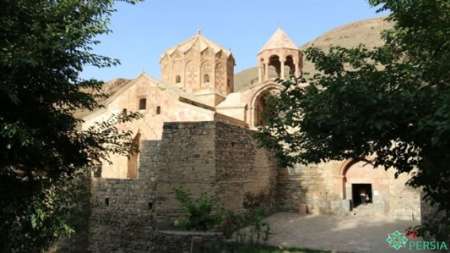It is among a handful of magnificent churches in Iran. The church's architectural style is a mixture of Urartan, Parthian, Greek, and Roman styles. It is considered as one of the architectural masterpieces of northwestern Iran.
There are a number of differing views about the history of the construction of this building. However, historic evidence, the type of construction, the building materials, the ornamentation, the philosophy behind the ornamentation, and the circumstances that allowed for the creation of this church, all attest to the fact that it was constructed during 10th to 12th centuries CE.
The church is located in the abandoned village of Dare Sham. Prior to 1971, it was accessible only by a dirt path. However, a road was constructed providing access by automobile.
According to historicaliran.blogspot.com, passing through an increasingly hilly terrain approaching a mountain, the dome of the entranceway to the Church of Saint Stephanos becomes visible. The dome of the entrance building has a width of four meters at its base, while the grounds are covered by a variety of trees. A large pool exists on the site with a clear and clean spring flowing to it. The fortifications for the monastery and church are located to the east of the site and consist of a tall rampart with seven watchtowers and five cylindrical buttresses.
The watchtower on the southwestern corner has crumbled, but the other portions of the fortification have remained relatively sound. The gateway to this rampart is situated in the center of the western wall.
It has a width of approximately one and a half meters, and a height of roughly two and a half meters. The door itself is made of wood, with wrought iron details, much in the style of fortress gates in the Safavid and Qajar eras. The pillars, and the dome above the gate are all constructed of red limestone and bear extensive masonry, and sculpted images. A stone relief of the Virgin Mary and the Infant Jesus is sculpted in the dome's vault. This gateway opens on to a dark passageway that is bound to monastery in the south, and the church in the north.
Once inside, one must pass through a narrow corridor, climb a few steps, and enter the church's courtyard. The church, which is constructed entirely of stone, consists of three distinct parts including the belfry, the church proper, and Daniel's furnace. The church proper has a height of an average three-story building with remarkable samples of masonry, sculpting and decorative work both in the interior and exterior parts of the building.
Remarkable stone relief of the disciples, saints, and angels have been sculpted on the faces of the 16-sided prismatic structure, which is considered as the impost for the tower of the church.
The interior part of the shrine which is laid out as a basilica, consists of three components including arcade, apse and altar. The balcony to the arcade is situated upon two stone demicolumns. The altar is located on the eastern side of the shrine with its base and surface made of marble.
There are a number of interesting objects within the shrine, of which two inlaid chairs, three images of Mary and Jesus, a brass reliquary, and four bibles stand out. The chairs date back to Safavid era, the paintings resemble those from the 17th and 18th centuries, the bones within the gilded reliquary are said to be those of Saint Gregory. According to Sarkis Misaghian, the oldest bibles date to the 17th century.
Daniel's furnace is a hall connected to the church's northern wall. It is divided into three parts including the furnace, a congregation space, and a baptismal fountain. The furnace is separated by a wall from the congregation hall which is located in the center of the space.
The baptismal urn is situated in the eastern extremity of the hall and stands in the middle of a high platform. The furnace is named after Saint Daniel, who was born in Syria. The bell tower is located on a two-story balcony that is connected to the church's southern wall. This tower is octagonal in shape, and stands on eight cylindrical columns, all of which are of the same red stone as the church.
In 2005, a team of Iran's Cultural Heritage, Handicrafts, and Tourism Organization (ICHHTO) who were studying documents from Iranian churches for international registration, discovered some bones in a box in the church. It is believed that the box consists of remains of John, the Baptist. Jean Baptiste Tavernier, a French traveler, recalls he saw the box when he was passing Saint Stephanos Church in 16th-early 17th century where he was told that the box belonged to one of the 12 Apostles of Christ.
9191**1424
Publish Date: 28 May 2015 - 12:56

Tehran, May 28, IRNA - The Church of Saint Stephanos, located in East Azarbaijan province, was built in the 9th century.